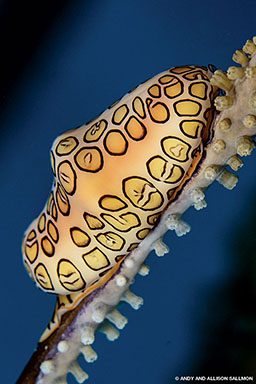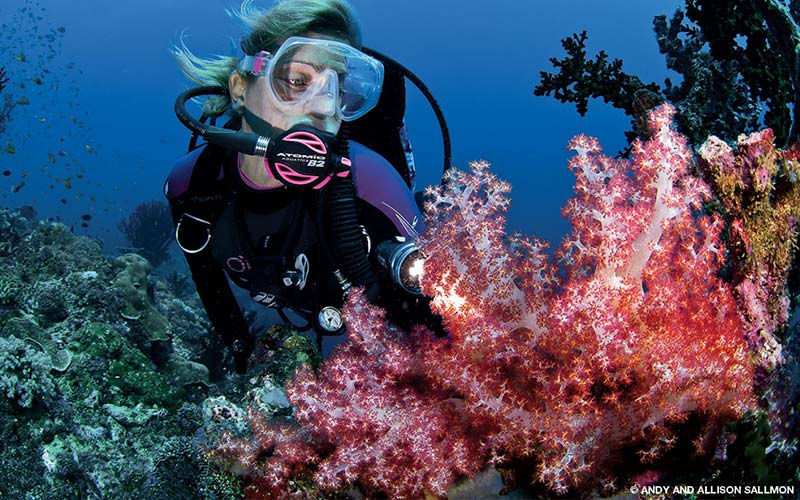
Not long ago, underwater shooters were largely divided into two camps: still photographers and videographers. This factional division was based on practicality more than argument — cameras were dedicated to either still or video imaging, and, given the associated costs, it made sense to pick a side and stick with it.
In more recent years, however, the lines have blurred. Most cameras now feature both still and video capabilities. Many topside photographers and videographers have embraced this versatility, but adoption has been slow in marine photography because of the particular lighting needs of underwater shooters.
Historically, underwater still photographers have carried strobes, which use capacitors to provide a momentary burst of light when the camera’s shutter is triggered. While some strobes have built-in continuous light functionality, these were more often used for aiming or assistance during night dives rather than emitting constant light bright enough to allow high-quality video imaging. At the same time, dedicated underwater video lights did not produce enough light to allow consistent, high-quality still photography. And carrying both types of lighting meant lugging around an inordinately bulky rig.
Recently, however, developments in LED (light-emitting diode) technology have allowed high-output, compact lights to become mainstream. At last, underwater shooters have access to light systems that can support both still and video imagery.
Features of LED Lights
Characteristics used to describe LED lights include lumen rating, burn time, beam angle, color-rendering index and color temperature. All must be considered from a practical standpoint when selecting a light for underwater still photography. Some units are tested according to the specification for flashlight performance issued by the American National Standards Institute and the National Electrical Manufacturers Association (ANSI/NEMA FL 1-2009 standard), which certifies that a light will perform as intended (e.g., an FL 1-compliant light is guaranteed to maintain its full lumen output throughout its burn time).
The lumen rating defines the amount of visible light emitted. In other words, this rating gives you the best indicator of an LED light’s power. While a few options exist that provide an output similar to strobes (8,000 lumens or more), for now the price tags of LED lights with this level of performance will deter many photographers. A light’s lumen rating represents its output at the highest power setting, so choosing a lower power setting decreases the light output proportionally. This may also affect a light’s burn time (or run time), a characteristic that describes how long the light will last at a specific lumen output, usually the light’s maximum, until it reaches 10 percent of the initial output measurement.

Beam angle is the angle at which the strength of the beam is half of the light’s maximum strength (the maximum strength is generally at the center). This is also known as the full-width at half-maximum (FWHM) potential. This represents one of the key differences between high-end strobes and LED lights intended for video use. Strobes, which are used to capture a momentary portrait or behavior, generally have a wider beam angle (110–120 degrees is common) than do LED lights (typically less than 100 degrees) since video is commonly used to capture dynamic subjects. Complicating this issue is the refractive index of water. When lights with flat lenses are submerged, the beam angle is reduced by as much as 33 percent, but many manufacturers report only the topside beam angle, which can confuse potential purchasers. A few manufacturers have made an effort to simplify matters by measuring and reporting the underwater beam angle; others have designed lights with a domed lens to eliminate this complication altogether.
Color rating, also known as color-rendering index (CRI), defines a light source’s ability to accurately depict the color spectrum compared to an ideal reference light of the same color temperature. CRI is expressed on a scale from 1-100; the higher the number, the more accurately colors will be reproduced. It is generally thought that a CRI of 90 or above is desirable for professional-level topside imaging. CRI is distinct from color temperature, expressed in degrees Kelvin, which characterizes light as warmer/yellower (lower values) or cooler/bluer (higher values). Most manufacturers of strobes and LED lights endeavor to achieve a color temperature near daylight balance (approximately 5500-6000K). In our experience, most brands of underwater LED lights tend to be slightly warmer than strobes, but minor temperature adjustments are easy to perform using basic postprocessing software.
Considerations & Techniques
In recent years a variety of LED lights created specifically for underwater imaging have become available, and the technology is continually and rapidly improving. The dazzlingly bright 14,000-lumen lights we used in Bonaire in 2015 were a far cry from the 500-lumen lights we first used for still imaging less than five years ago. While currently available LED lights are easily capable of illuminating a subject for still photography, they still lack the pop of power offered by many strobes. As a result, one of the key tenets of underwater photography becomes especially important when substituting the former for the latter: Get close.

Decreasing the distance to your subject will help your LED lights produce excellent foreground exposure, even in wide-angle scenes. To this end, using photographic equipment that permits very close focus, such as short-focal-length macro lenses or fisheye wide-angle lenses, is critical. It is often necessary to use a wider aperture with LED lights than one might choose when using strobes, and depending upon the strength of your lights and their beam width, it might be necessary to choose a smaller subject (such as a single branch of soft coral) as opposed to a larger one (such as a large rock covered with soft coral).
The relative limits of currently available LED lights may also affect composition. Whereas when using strobes we generally endeavor to approach subjects from below and shoot toward the ocean’s surface, LED lights do not always have the power to compensate for the faster shutter speeds sometimes required in bright conditions. For now, images featuring tight sunballs are far more likely to be achieved using strobes than a continuous light source.

Another consideration is your subject’s comfort. We can attest through firsthand experience that certain subjects (especially models) might become annoyed quickly when asked to pose facing blindingly bright continuous lights. And while some marine life won’t be bothered, there is simply no way to stealthily approach an animal with thousands of lumens of light continually emerging from your camera rig — and a shy species may not pose for even the briefest shot. Since burn time is a major limitation of currently available lights, you are unlikely to be swimming around with your lights constantly powered on, but even going through the motions of turning on your lights may disrupt some types of marine life. Although the compact size and light weight offered by some LED lights can be advantageous for travel, recent Federal Aviation Administration recommendations against packing lithium-ion batteries in checked luggage could mean adjusting your carry-on baggage plans to accommodate them.
Advantages

There are lots of advantages to using LED lights for still imaging. The ability to shift between video and still photography during a single dive without carrying multiple light sources (or worse yet, multiple dedicated camera systems) is the most obvious, and it’s a biggie. Many, if not most, cameras are capable of both formats, and the flexibility offered by a strong continuous light source might handily outweigh any disadvantages.
In many cases, LED lights are smaller and/or lighter than strobes, providing a size/weight advantage that is particularly beneficial when diving from shore, in current or in confined spaces. LED lights also help optimize autofocus in dark conditions, allow visualization of colors at depth and permit real-time adjustments that decrease the need for in-water image review, which means more time to capture images. While bracketing remains a good idea, photographers can use the light meter during shot setup to detect any major exposure problems and correct any unwanted highlights or shadows before releasing the shutter.
The same goes for detection of backscatter or flare: Issues can be spotted easily through the viewfinder, which helps to diminish unpleasant surprises during image review (or worse yet, time-consuming processing obligations after download). Photographers using continuous light sources also have fewer shutter-speed limitations compared with strobe users, because they don’t have to be concerned about synchronization or ghosting issues resulting from too-fast or too-slow shutter speeds, respectively.
Conclusion
Rapid, enormous advances in LED technology have given rise to a variety of compact, high-intensity lighting options for underwater image-makers. As a result, the use of LED lights in still imaging has become a useful illumination technique, allowing quick transition between videography and still photography and thus permitting shooters to choose how to document a subject during their dive. Certainly, there are differences between using strobes and LED lights for still imaging, but the gap has been substantially narrowed, and this trend will continue as improvements in batteries are made and more efficient LED technology is created.
Whether to hit the record button or shutter release is the new question. LED lighting is not meant to replace strobes for underwater still photography, but with some adaptation and compromise we now have the option for shooting stills and video with a single camera. Provided we have the bottom time, we can at last opt to capture a subject both ways during a single dive.
© Alert Diver — Q1 Winter 2016